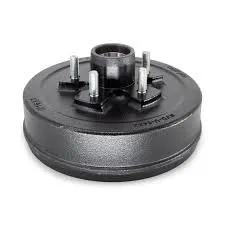Feb . 18, 2025 05:27
Back to list
drums on brakes
Understanding the Function and Maintenance of Drums on Brakes A Comprehensive Guide
1. Cleaning the brake assemblies to prevent dust accumulation, which may mute the needed friction. 2. Checking for heat spots and scoring on drums, as these can vastly reduce braking effectiveness. 3. Assessing brake shoe thickness meticulously, since wearing to minimum thickness thresholds can precipitate brake failure. 4. Ensuring hydraulic wheel cylinders are free from leaks that could hinder brake response. 5. Inspection of return springs to guarantee unhindered return of shoes after each brake application. Despite the apparent ease provided by self-adjusting mechanisms in drum brake systems, manual adjustment protocols remain paramount. Based on manufacturer guidelines, ensuring the shoes maintain slight contact with the drum keeps brake response crisp. Neglecting these measures translates into subpar customer experiences, a gap filled through adherence to detailed maintenance schedules which extend drum longevity and reliability. The advantage in fuel efficiency is an often overlooked benefit of drum brakes under specific configurations. Their lightweight design subsequently contributes to less extra weight within the vehicle dynamics framework, allowing superior mileage under proper conditions. Notably, industry experts acknowledge that trucks benefit from the lower thermal conductivity inherent in drum brakes. Safety remains an irrefutable pillar in discussions surrounding automotive components. Drum brakes warrant trust thanks to their straightforward refurbishment processes, facilitating cost-effective repairs and part replacements. The availability of components across global markets further cements their reliability footprint, often ubiquitous in inventory and part interchangeability paradigms. Conclusively, understanding and maintaining drums on brakes goes beyond mere technical adherence. It encapsulates the broader theme of vehicle reliability, ensuring each journey remains uninterrupted by mechanical failures. While evolving technologies beckon at the horizon with promises of enhanced performance, drum brakes maintain their rightful place by combining cost efficiency with robust, reliable functionality. Both automakers and end-users thus enjoy a harmonious relationship, grounded in mechanical intelligence and an unwavering pursuit of safe, sustainable vehicle operation. In the future, as automotive technology progresses, maintaining a fundamental understanding of drum brakes will continue to allow industry professionals to make informed decisions. Delving deeply into this established technology offers not only the assurance of safety and reliability but also the promise of longevity and resilience within the dynamic contours of modern vehicle engineering.


1. Cleaning the brake assemblies to prevent dust accumulation, which may mute the needed friction. 2. Checking for heat spots and scoring on drums, as these can vastly reduce braking effectiveness. 3. Assessing brake shoe thickness meticulously, since wearing to minimum thickness thresholds can precipitate brake failure. 4. Ensuring hydraulic wheel cylinders are free from leaks that could hinder brake response. 5. Inspection of return springs to guarantee unhindered return of shoes after each brake application. Despite the apparent ease provided by self-adjusting mechanisms in drum brake systems, manual adjustment protocols remain paramount. Based on manufacturer guidelines, ensuring the shoes maintain slight contact with the drum keeps brake response crisp. Neglecting these measures translates into subpar customer experiences, a gap filled through adherence to detailed maintenance schedules which extend drum longevity and reliability. The advantage in fuel efficiency is an often overlooked benefit of drum brakes under specific configurations. Their lightweight design subsequently contributes to less extra weight within the vehicle dynamics framework, allowing superior mileage under proper conditions. Notably, industry experts acknowledge that trucks benefit from the lower thermal conductivity inherent in drum brakes. Safety remains an irrefutable pillar in discussions surrounding automotive components. Drum brakes warrant trust thanks to their straightforward refurbishment processes, facilitating cost-effective repairs and part replacements. The availability of components across global markets further cements their reliability footprint, often ubiquitous in inventory and part interchangeability paradigms. Conclusively, understanding and maintaining drums on brakes goes beyond mere technical adherence. It encapsulates the broader theme of vehicle reliability, ensuring each journey remains uninterrupted by mechanical failures. While evolving technologies beckon at the horizon with promises of enhanced performance, drum brakes maintain their rightful place by combining cost efficiency with robust, reliable functionality. Both automakers and end-users thus enjoy a harmonious relationship, grounded in mechanical intelligence and an unwavering pursuit of safe, sustainable vehicle operation. In the future, as automotive technology progresses, maintaining a fundamental understanding of drum brakes will continue to allow industry professionals to make informed decisions. Delving deeply into this established technology offers not only the assurance of safety and reliability but also the promise of longevity and resilience within the dynamic contours of modern vehicle engineering.
Prev:
Next:
Latest news
-
Brake Drums for Trucks | OEM-Grade, Factory DirectNewsNov.10,2025
-
High-Performance Brake Drums for Trucks | OEM & ISONewsNov.10,2025
-
Brake Drums Built to Last — OEM-Grade, Balanced for TrucksNewsNov.10,2025
-
Brake Drums for Trucks – OEM-Grade, Durable, Low NoiseNewsNov.10,2025
-
Brake Drums for Trucks | OEM, ISO-Certified, Fast DeliveryNewsNov.10,2025
-
Brake Drums: OEM-Grade, Precision Balanced, Factory DirectNewsNov.03,2025
-
Brake Drums: Heavy-Duty, OEM-Grade, Precision-BalancedNewsNov.03,2025


